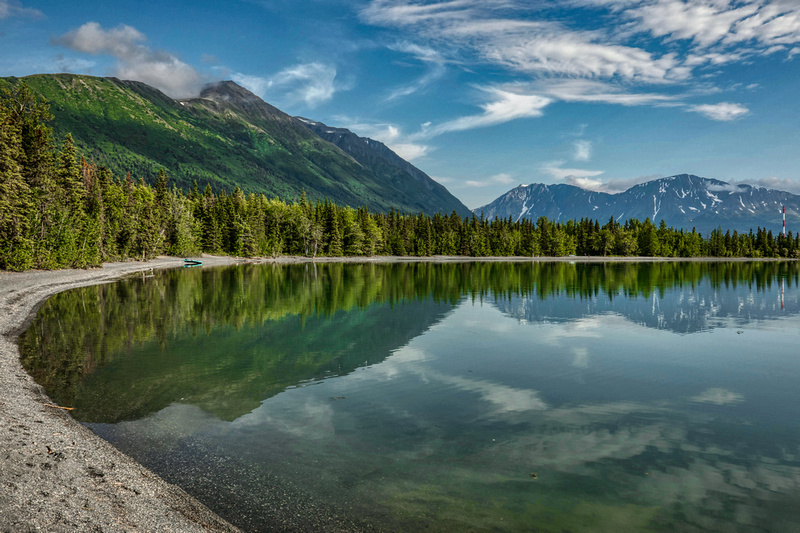A Week in Alaska
 A Week in AlaskaAn Alaskan Coastal Brown Bear walks in the pre-dawn morning along the low tide of the Cook Inlet
A Week in AlaskaAn Alaskan Coastal Brown Bear walks in the pre-dawn morning along the low tide of the Cook Inlet An Alaskan Coastal Brown Bear walks in the pre-dawn hours along the low tide area of the Cook Inlet in search of clams
An Alaskan Coastal Brown Bear walks in the pre-dawn hours along the low tide area of the Cook Inlet in search of clams
An Alaskan vacation is unforgettable in many ways. The days are long, the flowers are plentiful, and the wildlife can be observed throughout the state. The summer of 2021 was a perfect time to fly to the land of the midnight sun. After enduring the lockdowns and so much isolation from the Covid Pandemic in the year prior. Reservations were made, flights booked and a rental car secured early to get the best discounted prices. February and March seem to be the best months historically to book for Alaskan vacations.
My travel companion and friend, Natalie, and I arrived in Anchorage close to midnight and quickly made our way to our hotel to get some rest at the end of July. Our Itinerary for the week went something like this;
Day 1, this day was spent traveling to the Matanuska Valley. There, we were able to photograph the Matanuska Glacier, which is the largest glacier assessable by car in Alaska. The glacier is approximately 100 miles east of Anchorage. We also drove along the Little Susitna River enjoying the fireweed blooms and sweet aroma. I do believe there is no place more fragrant in all the world than along the river banks where the wildflowers blossom. Before departing the Matanuska Valley, we stopped by to the Independence Mine State Historical Park in the Hatcher Pass area where in the 1930’s gold was king!
Fun facts:
The average income in 1938 in this area was $1731.00 per year. A new home cost $3900.
The Matanuska Glacier feeds the Matanuska River and moves about 12 inches a day. Currently it is about 27 miles long in total.
For our evening lodging, Natalie and I rented a nice cabin with the Talkeetna Wilderness Lodge and Cabin Rentals. I highly recommend if wanting a small cabin in this area. Late in the evening, we dined in the quirky little town of Talkeetna. Let me just say that I love Talkeetna and enjoyed the outdoor dining and live music at the Mountain High Pizza Pie establishment. * Tip, if planning travel to Alaska on vacation, wear layers of clothing as it can be damp and cool in the summer and plan on meeting the largest mosquitos you have ever seen. In fact the gift shops sell T-shirts with a picture of a mosquito and the state of Alaska with the words, “The Alaska State Bird”. All I can say is True Dat. Dining outdoors had us zipping up our jackets and wearing Avon’s “Skin So Soft”, to repel those annoying blood sucking mosquitoes.
Fun Fact:
The mayor of the town of Talkeetna was Stubbs the cat. His office was located in the “Nagley’s General Store”, located on main street. He was mayor from 1997 until his death in 2017.


Matanuska Glacier

 Independence Mine State Historical Park, Hatcher Pass
Independence Mine State Historical Park, Hatcher Pass
For our evening lodging, Natalie and I rented a nice cabin with the Talkeetna Wilderness Lodge and Cabin Rentals. I highly recommend if wanting a small cabin in this area. Late in the evening, we dined in the quirky little town of Talkeetna. Let me just say that I love Talkeetna and enjoyed the outdoor dining and live music at the Mountain High Pizza Pie establishment. * Tip, if planning travel to Alaska on vacation, wear layers of clothing as it can be damp and cool in the summer and plan on meeting the largest mosquitos you have ever seen. In fact the gift shops sell T-shirts with a picture of a mosquito and the state of Alaska with the words, “The Alaska State Bird”. All I can say is True Dat. Dining outdoors had us zipping up our jackets and wearing Avon’s “Skin So Soft”, to repel those annoying blood sucking mosquitoes.
Fun Fact:
The mayor of the town of Talkeetna was Stubbs the cat. His office was located in the “Nagley’s General Store”, located on main street. He was mayor from 1997 until his death in 2017.
Day 2, This day was a fun filled indeed, as we drove from Talkeetna to Fairbanks Alaska for a 3 hour tour on the Riverboat Discovery paddleboat. During the tour, we stopped over at the Chena Indian Village Living Museum. There we were immersed in a guided walking tour of an Athabascan Village. We also were able to witness a Bush pilot demonstration on the Chena River as well as float on the river passing the “Trail Breaker Kennel”, where we were given a history lesson in dog mushing and of the late Susan Butcher, a four time Iditarod Champion. Later we dined at the historical landmark, The Pump House, overlooking the Chena River in Fairbanks. The food was delicious and the atmosphere very relaxing with much to take in all around. After dinner we traveled south, to the Denali Park Village for the night. The lodge was very comfortable and we slept soundly with the blackout curtains to help filter the daylight which fades a bit after midnight for a few hours.
Fun Facts:
Fairbanks is the only place in Alaska where a tornado has ever been recorded.
Fairbanks is a city of extreme temperatures. The highest temperature ever recorded in Fairbanks is 99 degrees in 1919. The coldest temperature -66 degrees in 1934.
During the winter solstice on December 21, Fairbanks only has 3 hours and 43 minutes of daylight, however on the summer solstice on June 21, there are 21 hours 49 minutes of daylight.
 The Riverboat Discovery paddle boat on the Chena River in Fairbanks
The Riverboat Discovery paddle boat on the Chena River in Fairbanks

The Athabaskan natives giving a cultural demonstration during a stop over at the Athabaskan Village


Bush pilot demonstration on the Chena River in Fairbanks during the Riverboat Discovery tour.
Day 3, After waking up for another day of adventure, Natalie and I headed into the Denali National Park to get a quick look at Denali which is the “star” of the park and is the tallest peak in North America. Denali is 20,310 ft. in elevation and is so tall that often the mountain peak is not visible. Fortunately for us Denali made an appearance briefly through the clouds and I was able to photograph the famous mountain in the distance. Denali National Park and Preserve straddle about 160 miles of the Alaska Range. The geology of the land is full of granite spires and snowy summits. This park is considered to be in the interior of Alaska’s wilderness and is home to Grizzly bears, wolves, moose, caribou, eagles, and Dall sheep as well as many other species of wildlife. With over 6 million acres there is plenty to roam for all sorts of amazing mammals. Although we only had a short time to see the park before heading to Whittier, we were able to photograph two cow moose in a river bed. If we had allotted more time in our trip, we would have opted to tour the park via the Denali National Park bus tour.
Fun Facts:
The only frog that is resident to the Denali National Park is the “Wood Frog”, who freezes itself into a cryogenic state in the cold winters. The heart and lungs of the frog cease to function until spring, when they thaw and life returns to normal for the little amphibians.
Denali was the first Alaskan National Park established in the state.
Denali means “The Great One” or the “High One” in the Athabascan language.
Around noontime, we continued our drive south to Whittier, small harbor town 58 miles south of Anchorage. The drive along the Cook Inlet was just “post card beautiful”. The town of Whittier rests on the west side of the Prince William Sound. Popular with photographers, many venture through the 13,300 foot long narrow Anton Anderson Memorial Tunnel, AKA the Portage Tunnel. It is the longest combined rail and highway tunnel in North America. Whittier is popular with photographers. The marina is very picturesque with the natural beauty and calm waters of the port often offer great reflection photos. Whittier is also a port for the ferries that travel the Alaska marine highway. The fisherman are friendly and are happy to talk with tourist telling tales about fishing in the Prince William Sound. On the way out we stopped to photograph the Portage Glacier and again… the aroma of the wildflowers, foliage and the damp earth was intoxicating. As the day came to a close, Natalie and I turn down our bedrolls at the Spruce Lodge in Seward.
Fun Facts:
Whittier is the wettest city in the United States receiving an average of 197.8 inches of rainfall each year and 249 inches of snow each winter.
After the 1964 Earthquake which measured 9.2 on the Richter scale, a Tsunami hit Whittier with the wave reaching 43 feet in height. The town sustained 10 Million in damages. That earthquake still is the largest earthquake ever recorded in the United States.
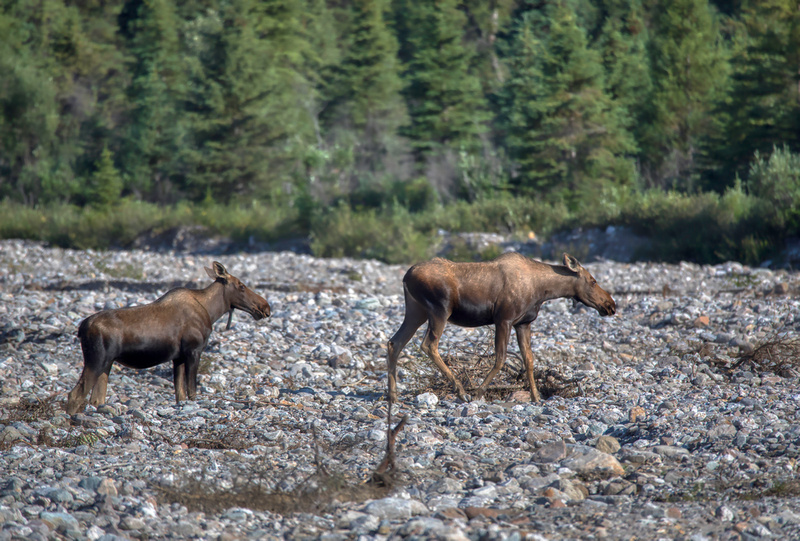
 Moose walking across a dry river bed in Denali National Park
Moose walking across a dry river bed in Denali National Park

 Fireweed and Lupine
Fireweed and Lupine
Day 4, Morning came early as we hurried down to the Kenai Fjords National Park boat tour for a 6 hour tour. The morning was perfect and we were treated to a glacier calving and wildlife viewing. It was perfect day on the water. The tour boat was large enough that we did not get sea sick. Sea Lions, Eagles, whales and the massive glaciers kept everyone busy photographing and videoing in every direction. As we cruised along, the Captain pointed out features and keeping everyone interested in marine life, history and features of the Kenai Fjords and Resurrection Bay. When traveling to Seward, this tour is a must.
In the afternoon after returning to the dock, we grabbed a bite to eat ordered local wild caught seafood. Thinking back, I believe we ate halibut at nearly every meal along with smoked salmon dip. Often our desserts consisted of a slice of homemade pie which are excellent and very delicious in Alaska.
The afternoon found us at Seavey’s Iditarod Dog Sled Tours, just outside of Seward. There we learned about the life of a sled dog, hearing tales from previous Iditarod races, holding new pups and going on a dog sled ride. What a hoot! More wonderful memories! Before departing Seward, we made a stop at the Exit Glacier and hiked the Exit Glacier Overlook trail where we took a few pictures of the Glacier before driving to Soldotna on the Kenai Peninsula. Once there we turned it in for the night at the Aspen Hotel.
Fun Facts:
Seward is “Mile 0” of the Historic Iditarod Trail.
Seward is also the most southerly terminal for the Alaska Railroad.
The Iditarod is the longest dog sled race in the world and starts the first Saturday in March and is roughly 1000 miles long.
Mitch Seavey still holds the world record for the winning time in March of 2017 finishing the race in 8 days, 3 hrs. 40 minutes and 13 seconds.
Sled dogs consume approximately 12,000 15,000 calories per day while participating the Iditarod race from Anchorage to Nome.

Coast Guard vessel USCG Mustang
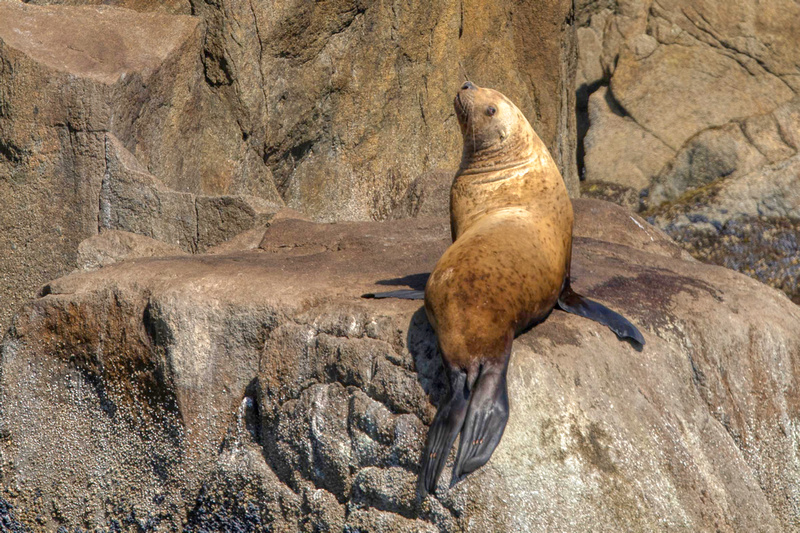
 Sea Lion seen sunning on rocks along the Kenai Fjords National Park boat tour
Sea Lion seen sunning on rocks along the Kenai Fjords National Park boat tour

 Another boat waiting to observe the glacier "calving", which is quite a spectacle
Another boat waiting to observe the glacier "calving", which is quite a spectacle

 Taking a ride behind the sled dog team at Seavey's Iditarod Dog Sled Tours in Seward.
Taking a ride behind the sled dog team at Seavey's Iditarod Dog Sled Tours in Seward.
Day 5 & 6
The icing on the cake per say, were these next couple of days. A favorite part of our trip was the Lake Clark National Park visitation. It started, with us boarding a small bush plane at the Soldotna airport, flying with Natron Air to the shores of the Lake Clark National Park. The flight was smooth as silk and the view was breathtaking. We were able to see rivers and valleys below as we flew over the Cook Inlet. The two active volcanos Redoubt and Illiamna rise from sea level to over 10,000 feet along with other rugged mountains. Both sit on the Alaska- Aleutian subduction zone.
Once we landed on the beach, we were greeted by the Alaska Homestead “bear guides” and transported to the lodge in ATV’s towing a passenger wagon with all our gear. Our stay at the lodge was wonderful, with the lodge owners, whom provided truly great Alaskan Hospitality. The meals were prepared using fresh ingredients grown at the lodge and seafood caught from the Cook Inlet. During the day hours, we spent hours traveling as passengers in the ATV wagon along the tree line trails, or walking with the guide through the sedge grass meadows or the sandy beach that borders the Cook Inlet. We observed and photographed the Coastal Brown bears and Bald Eagles. The Silver Salmon creek nearby is where many bears would be spotted waiting patiently waiting for the silver salmon to begin their annual run up the creek from the inlet. Photographing the bears with our guide Jake, was incredible. We were treated to the backstories on some of the resident bears that return to the area year after year to fatten up on the protein rich sedge grass and how they congregate at the creeks in late July, or August There they are observed feasting on salmon in order to gain weight for the coming winter. We even found wolf tracks on the beach. Jake was definitely an asset for the photographers as he always knew where to go and when to go. He knew how to keep us safe at all times and although we got a little nervous he calmly instructed us on what to do whenever a bear moved in our direction. Safety first was priority which Natalie and I appreciated.
Fun Facts:
The Alaskan Coastal Brown Bears (Ursus Arctos) can outrun a human and have been clocked running up to 30 mph. They can weigh up to 1500 pounds when living on a diet of spawning salmon. The largest subspecies of the brown bear is the Kodiak bear but not found at Lake Clark.
The shoulder hump is pure muscle on the brown bears and the grizzlies enabling them to dig and tear apart logs, prey and give them that extra strength.
Brown bears give birth while they sleep in hibernation. And the cubs make their way to their mother’s milk and nurse until the mother wakes up.
Lake Clark National Park and Preserve is about 6297 square miles with the land cover ranging from salt marshes on the coast to tall peaks and rolling tundra. There are two active volcanos with the last eruption recorded is the Redoubt Volcano erupting in 2009. The Iliamna volcano last erupted 1867 although it does send plumes of ash and smoke over the years.
The best months for a tourist to visit is the end of July through August when the bears are fattening up for winter on fish. Halibut fishing is also able to be arranged from Lake Clark National Park as well as clam digging.
The tide changes in the Cook Inlet can be extreme so boating, and landing a bush plane must have close monitoring of the high and low tides.
Summer activities of Lake Clark National Park and Preserve, include wildlife viewing, Sport fishing, and bird watching, Clam digging, hiking, and camping.
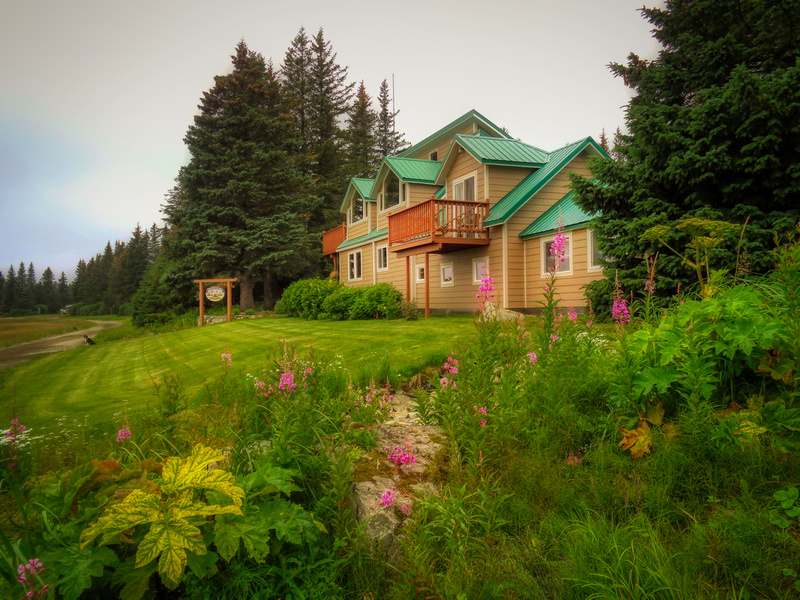
 The Alaska Homestead Lodge on the Lake Clark National Park & Preserve
The Alaska Homestead Lodge on the Lake Clark National Park & Preserve
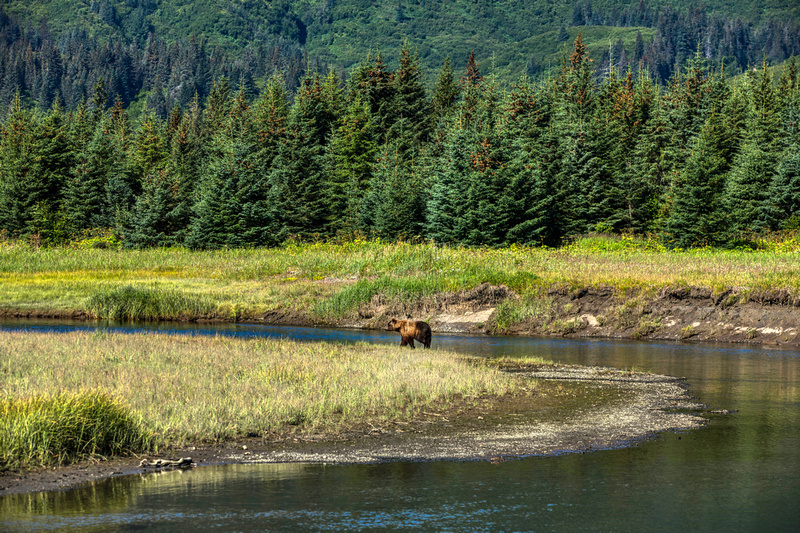
 The Silver Salmon Creek where the bears feed on the Salmon once the annual run begins on the Lake Clark N.P
The Silver Salmon Creek where the bears feed on the Salmon once the annual run begins on the Lake Clark N.P

 A sow and her two cubs grazing on the Sedge grass near the lodge
A sow and her two cubs grazing on the Sedge grass near the lodge

 Bald Eagles in the early morning mist along the shoreline
Bald Eagles in the early morning mist along the shoreline

 This image was taken at about 400 mm, this was when we got a little nervous but thanks to Jake our guide we remained safe
This image was taken at about 400 mm, this was when we got a little nervous but thanks to Jake our guide we remained safe
Day 7, Upon waking on our last day, a heavy fog moved in. The bush planes were not able to safely fly to pick us up on the beach. We were told to wait for the weather to clear, and just like that, a small window of opportunity for the Natron Air pilot presented itself and we were picked up at the same spot we were dropped off, then flew back to Soldotna to begin our journey back to Anchorage.
As we traveled along the beautiful Kenai River, we stopped for a last chance photography ops of the turquoise colored river. I personally, as always, was sad to leave Alaska. I love the wildness and magnificent beauty of the 49th state.

 A common sight in Alaska....a bush plane
A common sight in Alaska....a bush plane
So in closing, it was another Gypsy from Nowhere adventure that was worth blogging and sharing with others. What an amazing week spent in the Last Frontier….. Alaska.
